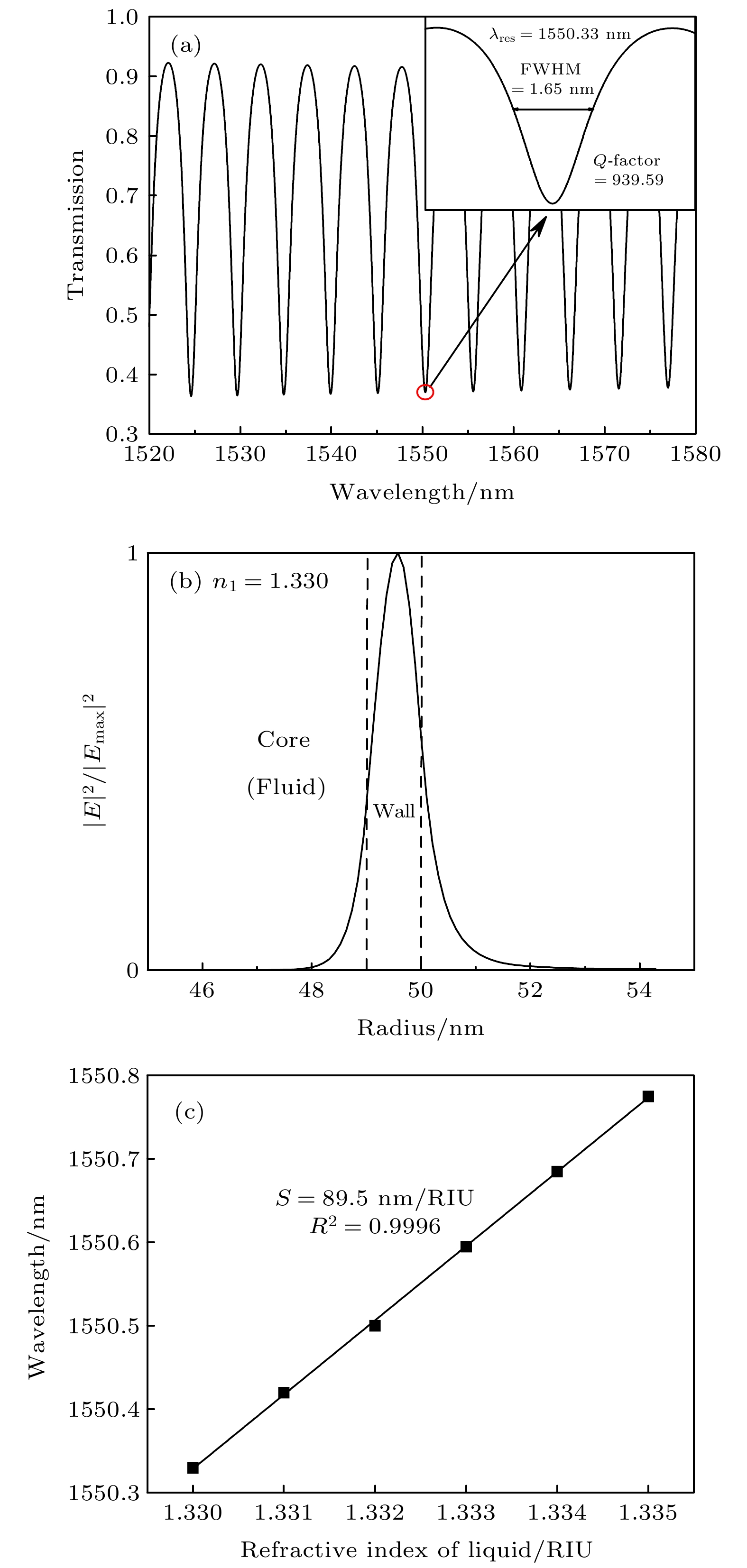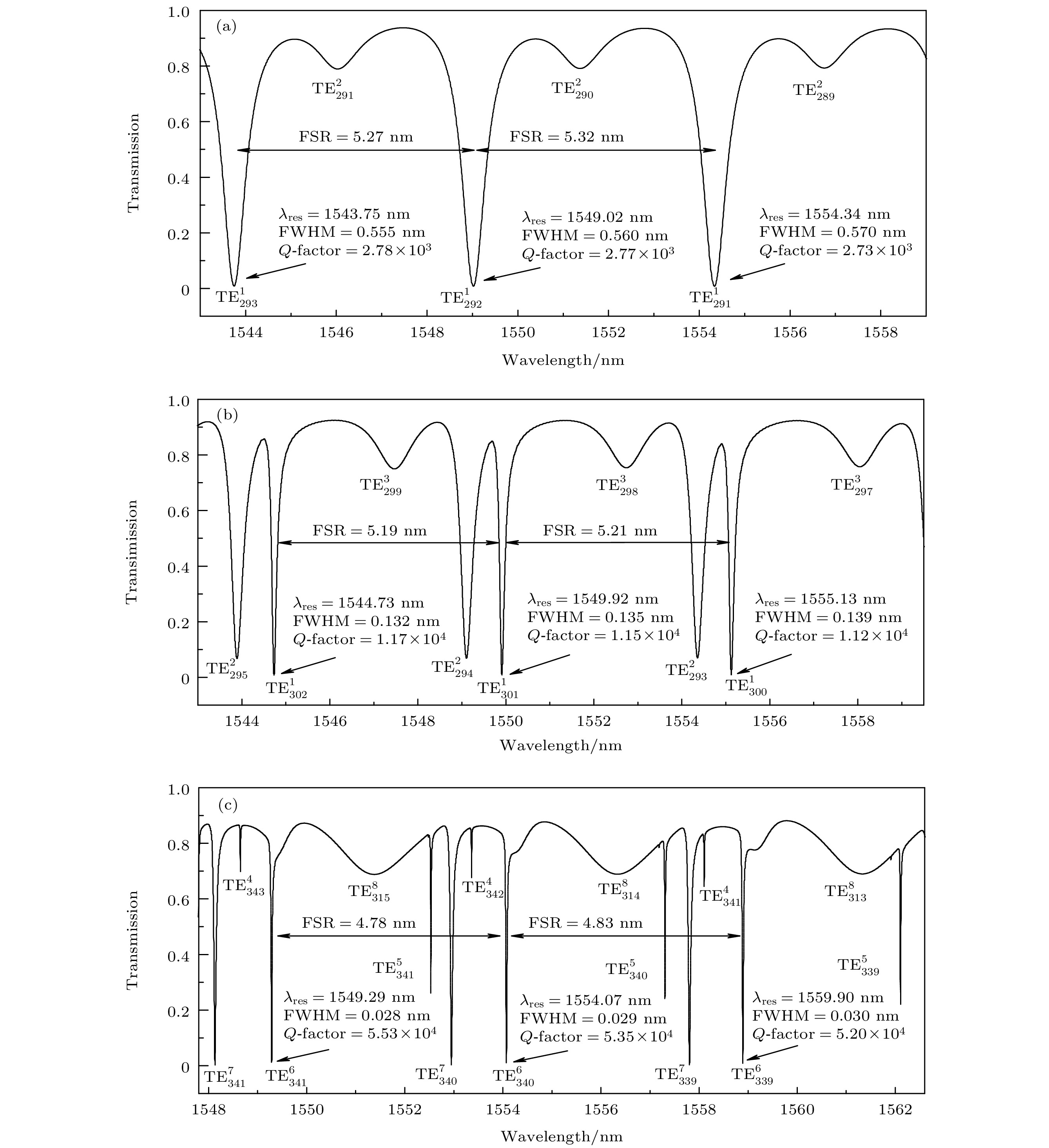-
Based on the coupling between the D-shape fiber and the microtube resonator in the whispering gallery mode, combined with the microfluidics, a refractive index sensor is proposed in this paper, in which the coupling region is fully encapsulated. This sensor requires a very little liquid sample (about 5 nL), is not fragile, and has better resistance to environmental perturbation, portability and repeatability than the general fiber-microcavity-coupled sensor. By the numerical simulation, the resonance properties of the microfluidic microtube resonator are investigated, and the refractive index sensing performance is analyzed. The research results show that the thickness of the mircotube-wall and the liquid refractive index have a great influence on the sensor performance. The shift of the resonance wavelength has a good linear relationship with the liquid refractive index. Meanwhile, the refractive index sensitivity is high (510.5–852.7 nm/RIU), and the Q-factor reaches up to 5.53×104, the detection limit can arrive at 2.11 × 10–6.
-
Keywords:
- optofluidics /
- D-type fiber /
- microtube resonator /
- refractive index sensor
[1] Dehghannasiri R, Soltani M, Adibi A 2017 J. Opt. Soc. Am. B 34 2259
 Google Scholar
Google Scholar
[2] Gardosi G, Mangan B J, Puc G S, Sumetsky M 2021 ACS Photonics 8 436
 Google Scholar
Google Scholar
[3] Vahala K J 2003 Nature 424 839
 Google Scholar
Google Scholar
[4] Ajad A K, Islam M J, Kaysir M R 2020 11th International Conference on Electrical and Computer Engineering Dhaka, Bangladesh, December 17–19, 2020 p202
[5] Chang Y H, Dong B W, Ma Y M, Wei J X, Ren Z H, Lee C K 2020 Opt. Express 28 6251
 Google Scholar
Google Scholar
[6] Zhang M, Cheng W F, Zheng Z, Cheng J G, Liu J S 2019 Microfluid. Nanofluid. 23 1
 Google Scholar
Google Scholar
[7] Wang Z, Mallik A K, Wei F F, Wang Z C, Rout A, Wu Q, Semenova Y Y 2021 Opt. Express 29 23569
 Google Scholar
Google Scholar
[8] da Silva J, Salameh E, Ötügen M V, Fourguette D 2021 Appl. Opt. 60 1434
 Google Scholar
Google Scholar
[9] Zhang Y N, Zhou T M, Han B, Zhang A Z, Zhao Y 2018 Nanoscale 10 13832
 Google Scholar
Google Scholar
[10] Yan Y Z, Zou C L, Yan S B, et al. 2011 IEEE Photonics Technol. Lett. 23 1736
 Google Scholar
Google Scholar
[11] Zhang Y N, Zhu N S, Zhou T M, Zheng Y, Shum P P 2019 IEEE Sens. J. 20 833
 Google Scholar
Google Scholar
[12] Monifi F, Ozdemir S K, Friedlein J, Yang L 2013 IEEE Photonics Technol. Lett. 25 1458
 Google Scholar
Google Scholar
[13] Duduś A, Blue R, Uttamchandani D 2013 IEEE Sens. J. 13 1594
 Google Scholar
Google Scholar
[14] Wan H D, Chen J J, Wan C, Zhou Q, Wang J, Zhang Z X 2019 Biomed. Opt. Express 10 3929
 Google Scholar
Google Scholar
[15] Fan S, Healy N 2020 Opt. Lett. 45 4128
 Google Scholar
Google Scholar
[16] Jiang L, Zhao L, Wang S, et al. 2011 Opt. Express 19 17591
 Google Scholar
Google Scholar
[17] Zakaria R, Zainuddin N M, Fahri M A S A, et al. 2021 Opt. Fiber Technol. 61 102449
 Google Scholar
Google Scholar
[18] 张兴旺 2014 博士学位论文 (上海: 复旦大学)
Zhang X W 2014 Ph. D. Dissertation (Shanghai: Fudan University) (in Chinese)
[19] Zamora V, Díez A, Andrés M V, Gimeno B 2007 Opt. Express 15 12011
 Google Scholar
Google Scholar
[20] Foreman M R, Swaim J D, Vollmer F 2015 Adv. Opt. Photonics 7 168
 Google Scholar
Google Scholar
[21] Okamoto K 2021 Fundamentals of Optical Waveguides (Vol. 3) (Amsterdam: Elsevier) pp211–325
[22] Ling T, Guo L J 2007 Opt. Express 15 17424
 Google Scholar
Google Scholar
[23] Wang Y J, Zhang H, Duan S X, Lin W, Liu B, Wu J X 2020 IEEE Sens. J. 21 9148
 Google Scholar
Google Scholar
[24] Cao J W, Wang Q, Chai Z E, Zhu Y X, Liu H, Liu K, Ren X M 2018 Asia Communications and Photonics Conference Hangzhou, China, October 26–29, 2018 pSu2A.238
-
图 2 管芯液体折射率n1为1.330时的传感特性 (a) 输出光谱, 其中右上角是谐振波长λres为1550.33 nm时对应的半高线宽(FWHM)和Q值; (b) 微管谐振腔中光场径向分布, 其中两条虚线所夹空间为微管壁; (c) 折射率灵敏度曲线
Figure 2. Sensing characteristics under the liquid refractive index n1 of 1.330: (a) Output spectrum, where there is the FWHM and Q-factor of the resonant wavelength (λres) of 1550.33 nm at the top-right corner; (b) radial distribution of optical field in the microtube resonator, and the space between two dotted lines is the microtube wall; (c) curve of the refractive index sensitivity.
图 3 微管壁厚度不同时的输出光谱, 其中右上角是待测液体折射率n1为1.450—1.458时的灵敏度曲线, 图(a)—(c)对应的微管壁厚度分别为(a) 1.5 μm; (b) 1 μm; (c) 0.5 μm
Figure 3. Output spectra corresponding to different microtube-wall thicknesses, where there is the sensitivity curve corresponding to the liquid refractive index n1 of 1.450–1.458 at the top-right corner, and the microtube-wall thickness is (a) 1.5 μm, (b) 1 μm, (c) 0.5 μm
表 1 不同微管壁厚度的传感器性能
Table 1. Sensor properties of different microtube-wall thicknesses.
微管壁的
厚度/μm液体的折射率 1.450—1.458 1.500—1.504 Q 值 灵敏度/
(nm·RIU–1)Q 值 灵敏度/
( nm·RIU–1)1.5 2.42 × 103 238.3 1.10 × 104 709.7 1 2.77 × 103 510.7 1.15 × 104 815.6 0.5 3.86 × 103 805.2 5.00 × 104 914.4 表 2 传感器的输出特性
Table 2. Output characteristics of the sensor
液体折射率 谐振
模式谐振波
长/nm自由光谱
范围/nm半高线
宽/nmQ值 1.450 $ {\mathrm{T}\mathrm{E}}_{293}^{1} $ 1543.75 5.27
5.320.555 2.78 × 103 $ {\mathrm{T}\mathrm{E}}_{292}^{1} $ 1549.02 0.560 2.77 × 103 $ {\mathrm{T}\mathrm{E}}_{291}^{1} $ 1554.34 0.570 2.73 × 103 1.500 $ {\mathrm{T}\mathrm{E}}_{302}^{1} $ 1544.73 5.19
5.210.132 1.17 × 104 $ {\mathrm{T}\mathrm{E}}_{301}^{1} $ 1549.92 0.135 1.15 × 104 $ {\mathrm{T}\mathrm{E}}_{300}^{1} $ 1555.13 0.139 1.12 × 104 1.700 $ {\mathrm{T}\mathrm{E}}_{341}^{6} $ 1549.29 4.78
4.860.028 5.53 × 104 $ {\mathrm{T}\mathrm{E}}_{340}^{6} $ 1554.07 0.029 5.36 × 104 $ {\mathrm{T}\mathrm{E}}_{339}^{6} $ 1558.90 0.030 5.20 × 104 表 3 传感器性能
Table 3. Sensor performance.
液体折射率 Q值 灵敏度/(nm·RIU–1) 探测极限 1.450—1.458 (2.73—2.78) × 103 510.5—515.3 (6.52—6.63) × 10–5 1.500—1.504 (1.12—1.17) × 104 813.1—818.3 (0.97—1.02) × 10–5 1.696—1.700 (5.20—5.53) × 104 848.2—852.7 (1.98—2.11) × 10–6 -
[1] Dehghannasiri R, Soltani M, Adibi A 2017 J. Opt. Soc. Am. B 34 2259
 Google Scholar
Google Scholar
[2] Gardosi G, Mangan B J, Puc G S, Sumetsky M 2021 ACS Photonics 8 436
 Google Scholar
Google Scholar
[3] Vahala K J 2003 Nature 424 839
 Google Scholar
Google Scholar
[4] Ajad A K, Islam M J, Kaysir M R 2020 11th International Conference on Electrical and Computer Engineering Dhaka, Bangladesh, December 17–19, 2020 p202
[5] Chang Y H, Dong B W, Ma Y M, Wei J X, Ren Z H, Lee C K 2020 Opt. Express 28 6251
 Google Scholar
Google Scholar
[6] Zhang M, Cheng W F, Zheng Z, Cheng J G, Liu J S 2019 Microfluid. Nanofluid. 23 1
 Google Scholar
Google Scholar
[7] Wang Z, Mallik A K, Wei F F, Wang Z C, Rout A, Wu Q, Semenova Y Y 2021 Opt. Express 29 23569
 Google Scholar
Google Scholar
[8] da Silva J, Salameh E, Ötügen M V, Fourguette D 2021 Appl. Opt. 60 1434
 Google Scholar
Google Scholar
[9] Zhang Y N, Zhou T M, Han B, Zhang A Z, Zhao Y 2018 Nanoscale 10 13832
 Google Scholar
Google Scholar
[10] Yan Y Z, Zou C L, Yan S B, et al. 2011 IEEE Photonics Technol. Lett. 23 1736
 Google Scholar
Google Scholar
[11] Zhang Y N, Zhu N S, Zhou T M, Zheng Y, Shum P P 2019 IEEE Sens. J. 20 833
 Google Scholar
Google Scholar
[12] Monifi F, Ozdemir S K, Friedlein J, Yang L 2013 IEEE Photonics Technol. Lett. 25 1458
 Google Scholar
Google Scholar
[13] Duduś A, Blue R, Uttamchandani D 2013 IEEE Sens. J. 13 1594
 Google Scholar
Google Scholar
[14] Wan H D, Chen J J, Wan C, Zhou Q, Wang J, Zhang Z X 2019 Biomed. Opt. Express 10 3929
 Google Scholar
Google Scholar
[15] Fan S, Healy N 2020 Opt. Lett. 45 4128
 Google Scholar
Google Scholar
[16] Jiang L, Zhao L, Wang S, et al. 2011 Opt. Express 19 17591
 Google Scholar
Google Scholar
[17] Zakaria R, Zainuddin N M, Fahri M A S A, et al. 2021 Opt. Fiber Technol. 61 102449
 Google Scholar
Google Scholar
[18] 张兴旺 2014 博士学位论文 (上海: 复旦大学)
Zhang X W 2014 Ph. D. Dissertation (Shanghai: Fudan University) (in Chinese)
[19] Zamora V, Díez A, Andrés M V, Gimeno B 2007 Opt. Express 15 12011
 Google Scholar
Google Scholar
[20] Foreman M R, Swaim J D, Vollmer F 2015 Adv. Opt. Photonics 7 168
 Google Scholar
Google Scholar
[21] Okamoto K 2021 Fundamentals of Optical Waveguides (Vol. 3) (Amsterdam: Elsevier) pp211–325
[22] Ling T, Guo L J 2007 Opt. Express 15 17424
 Google Scholar
Google Scholar
[23] Wang Y J, Zhang H, Duan S X, Lin W, Liu B, Wu J X 2020 IEEE Sens. J. 21 9148
 Google Scholar
Google Scholar
[24] Cao J W, Wang Q, Chai Z E, Zhu Y X, Liu H, Liu K, Ren X M 2018 Asia Communications and Photonics Conference Hangzhou, China, October 26–29, 2018 pSu2A.238
Catalog
Metrics
- Abstract views: 5157
- PDF Downloads: 89
- Cited By: 0















 DownLoad:
DownLoad:





